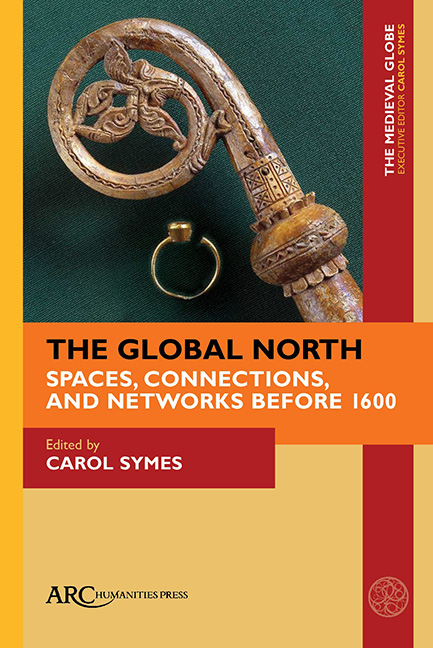Book contents
- Frontmatter
- Contents
- List Of Illustrations
- Introduction: Exploring the Global North, from the Iron Age to the Age of Sail
- Contesting Marginality: The Boreal Forest of Middle Scandinavia and the Worlds Outside
- Archaeological Evidence for Staraya Lagoda as an Early Scandinavian Emporium of the Global North
- Gunhild’s Cross and the North Atlantic Trade Sphere
- The Far North in the Eyes of Adam of Bremen and the Anonymous Author of the Historia Norwegie
- The Multi-Layered Spatiality of the Global North: Spatial References and Spatial Constructions in Medieval East Norse Literature
- Military Migration in the Baltic Sea Region, ca. 1400–1620
- Old and New Land in the North and West: The North Atlantic on the Medieval Globe around 1500
- Index
Gunhild’s Cross and the North Atlantic Trade Sphere
Published online by Cambridge University Press: 20 January 2022
- Frontmatter
- Contents
- List Of Illustrations
- Introduction: Exploring the Global North, from the Iron Age to the Age of Sail
- Contesting Marginality: The Boreal Forest of Middle Scandinavia and the Worlds Outside
- Archaeological Evidence for Staraya Lagoda as an Early Scandinavian Emporium of the Global North
- Gunhild’s Cross and the North Atlantic Trade Sphere
- The Far North in the Eyes of Adam of Bremen and the Anonymous Author of the Historia Norwegie
- The Multi-Layered Spatiality of the Global North: Spatial References and Spatial Constructions in Medieval East Norse Literature
- Military Migration in the Baltic Sea Region, ca. 1400–1620
- Old and New Land in the North and West: The North Atlantic on the Medieval Globe around 1500
- Index
Summary
ON A GRASSY sheep farm in Igaliku, a small settlement in southern Greenland, reclines a perimeter of red stones. These lichen-covered ruins huddle in view of an inlet of the North Atlantic and craggy, cloud-cloaked peaks. This is the footprint of Garðar Cathedral, the episcopal seat of Norse Greenland. It has been abandoned since the fifteenth century, when a colonial venture spanning five hundred years mysteriously ended. During a period of expansion and success in the settlement during the twelfth century, the older Garðar Cathedral was replaced with a new building, one with a much larger footprint, perhaps to welcome a new bishop and the growing congregation. This second Garðar Cathedral had a differentiated chancel and two chapels. The sandstone used in the church's twelfth-century construction was quarried locally in the nearby mountains. Dedicated to St. Nicholas, the patron saint of sailors, it had a bell tower and windows of coloured glass. Though there were at least seventeen other small, privately owned churches in Norse Greenland, the cathedral marked the spiritual centre of the community and signalled the ambitions of the local elite.
The Walruses at the Altar
When Poul Nørland excavated the church in 1929, in addition to the human remains in the churchyard and those in the chapels, he discovered the remains of other Greenland inhabitants, their heads aligned on the East–West axis like all the people interred there. Buried in neat rows, twenty to thirty walrus skulls were discovered along the eastern gable of the cathedral chancel, all with their tusks removed. In addition, four to five Narwhal skulls were buried in the sanctified ground of the churchyard beside their settler neighbours. Initially, Nørland interpreted these rows of skulls as evidence of an earlier, pre-Christian site, and the team of researchers led by Karin Frei later suggested that these were incorporated into the cemetery when it expanded into nearby refuse heaps. However, the dating of these skulls to the late eleventh and early twelfth century, as well as their position in relationship to the church, aligned with the architecture, suggest that their interment was rather part of the ritual dimensions of the Christian site. This Arctic intervention within the footprint of the cathedral actualizes an encounter between the imported liturgical space and the nonhuman presence with which it shared the land.
- Type
- Chapter
- Information
- The Global NorthSpaces, Connections, and Networks before 1600, pp. 53 - 76Publisher: Amsterdam University PressPrint publication year: 2021



